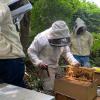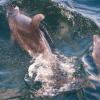Groupers (Pisces: Serranidae) in fished and protected areas of the Florida Keys, Bahamas and northern Caribbean
Groupers (Pisces: Serranidae) of littoral environments of warm-temperate and tropical regions have experienced intense fishery exploitation. Indicators of intense fishing include declines or change in abundance, size, spawning aggregations, and species composition. Surveys of grouper were carried out from 1995 to 1997 in the Florida Keys, central Bahamas, southeastern Cuba, and the southeastern Dominican Republic to illuminate patterns in species composition, abundance, and size, along a gradient of relative fishing pressure. We assumed that the diversity, composition, density, and size would serve as indicators of fishing pressure in these areas. The study locations included 2 national parks and a national marine sanctuary, and were categorized as: (1) intensively fished with little or no management for groupers (southeastern Cuba, southeastern Dominican Republic), (2) intensively fished with numerous gear and effort regulations (Florida Keys), (3) lightly fished with some gear and effort regulations (northern and southern Exuma Cays, Bahamas), and (4) a no-take marine fishery reserve closed to fishing (Exuma Cays Land and Sea Park, Bahamas). On each site 10 to 20 strip transects (20 m x 5 m) were surveyed in water of 1 to 20 m depth over rocky hard-bottom habitats for density and size of grouper. Nine grouper species (2 Cephalopholis spp., 4 Epinephelus spp., and 3 Mycteroperca spp.) were documented among all areas. Results show that areas where grouper fishing was relatively light had greater numbers of species, density, and biomass, particularly for larger species such as Nassau grouper E. striatus. Classification of groupers by 3 life history categories or growth strategies (small, intermediate, and large) indicated significant differences in density and biomass among study areas. The density and biomass of larger grouper species were significantly greater in the no-take marine reserve and lightly fished areas than in the more intensively fished areas. In 3 of the areas characterized as intensively fished, one of which has several grouper fishery regulations, grouper density and biomass were dominated by small, non-targeted species such as the graysby C. cruentatus and the coney C. fulva. This pattern may indicate a second-order effect of fishing, indicative of potential changes in competition or predation. No-take marine fishery reserves represent a viable means to protect grouper resources, simplifying enforcement relative to complex catch and effort regulation, but also potentially alleviating the need to gather fisheries-dependent data.
Area of Interest: Bahamas
Year: 2000




